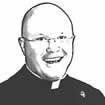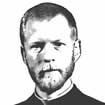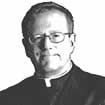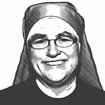
Culture

Lester
On Sunday, Oct. 20, St. Peter Lithuanian Parish in South Boston will be commemorating 120 years since the blessing of the church by its first pastor.
Lithuanians began immigrating to the U.S. in significant numbers around 1870 and it is believed there were about 1,000 in Boston by 1890; many of them concentrated in South Boston. While some could speak Polish and have their religious needs met at Our Lady of Czestochowa, many desired a priest who understood their own language and customs, and a solution was presented in the form of Joseph Gricius.
A Lithuanian who had studied theology, Gricius arrived in 1894 and Archbishop John Williams, aware of the need for a Lithuanian priest, paid for him to complete his studies at St. John's Seminary and he was ordained a priest of the archdiocese the following year.
His first assignment was to care for Lithuanian Catholics in South Boston and, while he was given a residence in that neighborhood, Mass was held at Holy Trinity in Boston's South End. The situation proved only temporary, since in February 1896, he was able to purchase land on Seventh Street in South Boston and converted one of the houses on the property into a chapel.
Sadly, on Feb. 8, 1899, the chapel burned down and, in addition to being a tragedy, marked the appearance of a fissure in the Lithuanian Catholic community. While some parishioners wanted to help Father Gricius rebuild, others were not satisfied with his leadership and wished to request a new pastor and build their own church.
It is unclear whether parishioner discontentment preceded the fire or originated with the discussion about rebuilding the chapel. A historian of the parish admitted being unable to identify the root cause, speculating it could have been one or several issues, including Gricius' lack of tact (attributed to his age), his Lithuanian dialect being difficult to understand, or his insistence on controlling the finances and decisions of the proposed rebuild.
Nevertheless, the chapel was rebuilt, and Father Gricius remained pastor until his departure from the archdiocese in the summer of 1914. Meanwhile, on March 24, 1899, just three months after the fire, the parishioners who desired a fresh start formed a committee to oversee the construction of their own new church and purchased land on West Fifth Street for that purpose. Determined to build a large brick church, as opposed to a more affordable wooden structure, parishioners donated their time and skill digging the foundation and contributing in other ways so that it was completed by 1901.
With the new church complete, the parishioners appealed to Archbishop Williams for a Lithuanian priest, but Father Gricius was the only one available and his personal attempts to reunite the two congregations proved fruitless. In 1903, they were able to bring a priest from Lithuania to the U.S. but, after meeting with him, Archbishop Williams became convinced that a priest who had experience in the U.S. would be more suitable. Following his advice, the parishioners then approached Father Jonas Zilinskas (sometimes John Zellinski) who was residing in Pennsylvania.
When Lithuanian immigrants first began to arrive in the U.S., many were drawn to Pennsylvania, where there was ready work in the coal fields, and where Father Zilinskas had been ordained in 1894. Now, 10 years later, after two visits with Archbishop Williams, he received permission to be the new pastor of St. Peter's and blessed the new church himself on Jan. 31, 1904.
There were a few administrative matters, a resolution to which Father Zilinskas began working immediately. First, he ensured there was clarity over the boundary between St. Peter and Father Gricius' parish; the latter sometimes referred to as St. Joseph or St. Casimir. Second, the church was owned by the committee that oversaw its construction, so he first leased it from them, then arranged the sale to Archbishop Williams.
With these matters resolved, a second ceremony took place on Monday, Sept. 7, 1908, Labor Day that year. Over 2,000 people, including many Lithuanian lay organizations, processed behind 23 banners and nine bands from the train station to the church where Auxiliary Bishop of Boston John Brady solemnly blessed and dedicated the church, after which he laid an ornamental cornerstone and celebrated a Solemn High Mass.
Over the ensuing years, the parish would flourish, expanding its footprint with the purchase of adjacent lots and construction of a new rectory shortly after. In 1918, a summer school was commenced to teach parish children born in the U.S. the Lithuanian language and customs in an effort to preserve both. Sunday school began in 1924, and 10 years later, lay teachers were replaced by the Sisters of Jesus Crucified, who would also establish the parish grammar school in 1945. There were also countless lay organizations that made for a vibrant parish life, including the Knights of Lithuania and Lithuanian Catholic Workers Alliance, to name a few. It is suggested that readers wishing to learn more about these organizations and the parish, overall, consult "The History of St. Peter's Lithuanian Parish, South Boston," by Dr. Antanas Kucas; translated by Father Albert J. Contons (Boston: 1956).
To mark the 120th anniversary, on Sunday, Oct. 20, there will be a concert of religious music at 10:30 a.m., followed by a Mass at 11 a.m. celebrated by Bishop Cristiano Barbosa, with all those attending invited to participate in a special luncheon in the church hall immediately after.
- Thomas Lester is the archivist of the Archdiocese of Boston.
Recent articles in the Culture & Events section
-
Family and friends, the 2024 election and ThanksgivingElizabeth Scalia
-
Cardinal O'Connell's 1909 Thanksgiving Day addressThomas Lester
-
Promise and peril of AIRussell Shaw
-
Building a legacyMichael Reardon
-
Scripture Reflection for Nov. 24, 2024, Solemnity of Our Lord Jesus Christ, King of the UniverseDeacon Greg Kandra


















